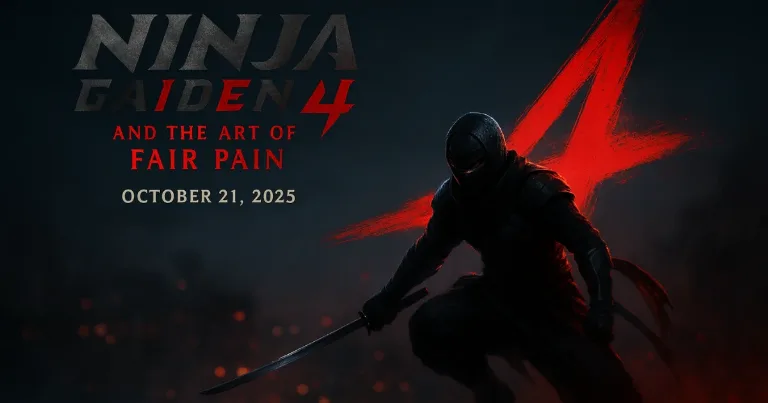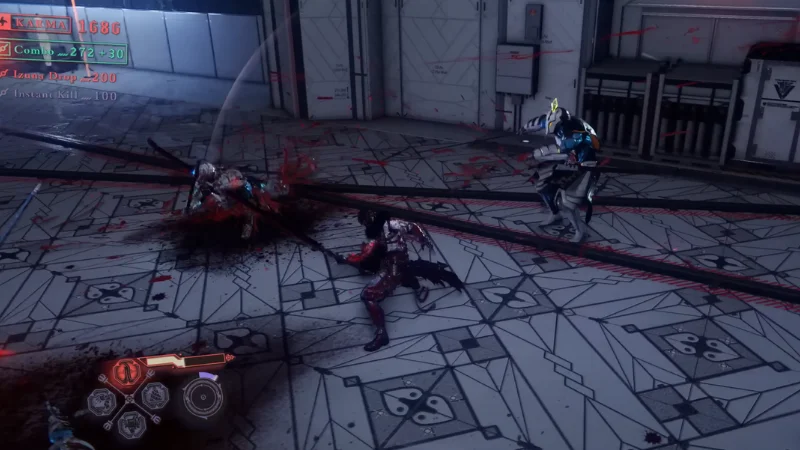Ninja Gaiden 4 and the Art of Fair Pain

Ninja Gaiden 4 and the Art of Fair Pain
A hard game can feel kind. Not soft, not easy, just honest. Ninja Gaiden 4 launches tomorrow, October 21, 2025. When a hit lands, you understand why. When you fall, you see a way to stand again. That is fair pain.
Launch platforms and price
| Platform | Where | Price |
|---|---|---|
| Xbox Series X|S | Microsoft Store, Game Pass | Standard 69.99 USD, Deluxe 89.99 USD, Day one on Game Pass |
| PlayStation 5 | PlayStation Store | Standard 69.99 USD, Deluxe 89.99 USD |
| PC | Steam, Microsoft Store | Standard 69.99 USD, Deluxe 89.99 USD |
What “fair pain” means in this game
Hard, yet readable. Every mistake has a reason, and every reason points to a response. No mystery damage. No guess traps. You learn, try again, and adjust.
Two checks I use when a fight feels rough:
-
Could I read the hit before it landed. If yes, the loss is on me. If no, the game failed to tell.
-
Did the next try give me a real way to change. If yes, the system is fair. If no, the design needs a tweak.
This lens fits the Ninja Gaiden legacy. Old games were sharp and strict, yet the best runs felt earned, not random. Ninja Gaiden 4 aims to keep that feeling while giving clearer signals and better recovery tools.
Same rules, same stakes, same tools
Fair pain starts when everyone follows the same rules. Your stamina and enemy stamina obey one idea. If a move is punishable on you, it is punishable on them. If a grab has a tell for you, it has a tell for them.
Honest numbers matter. When health loss and damage output stay steady, you can sense risk. You start to trade on purpose. You do not fish for lucky hits. You plan, then you commit.
Read the fight fast, then act

This game wants your eyes calm and quick. Enemies show intent with posture, sound, and windup. Big swings have weight. Feints have short tells that repeat. You learn the set, then you dance.
Camera and space help the read. The camera keeps the threat in view. The arena shapes lanes where you can step, bait, and punish. When you can see, you can choose.
A tiny drill to try in the first hour:
-
Enter a fight and do not attack for ten seconds. Just watch. Count the three most common tells. Say them out loud. Then play for real. You will see your win rate rise.
Inputs that never lie
Hands need trust to build skill. When you press block, it blocks at once. When you cancel, it cancels on the same frame each time. Parry, block, and dodge each have a job.
-
Block for safety, low risk, low reward.
-
Parry for swing, high risk, high reward. It opens a punish window.
-
Dodge for space, mid risk, clear reward. It resets your angle.
When inputs are tight, the lesson is clear. You missed the parry, not the game. You misread the grab, not the camera. That is fair.
Help that trains, not cheats
Assists are tools, not crutches. They reduce noise and teach timing. You can step them down as you grow.
The ladder looks like this:
-
Turn on Auto Block to learn the shape of a fight. Feel the rhythm without the panic.
-
Add Auto Evade in new zones to watch big moves and tells. Use it like a replay, but live.
-
Use Auto Assist on a tough boss for ten tries. Study openings and punish routes. Turn it off once the pattern clicks.
Do not fear the options. Fair pain means growth, not gatekeeping. If a tool helps you learn, it belongs.
When it still feels unfair
Every tough game has sore spots. Here are five common moments and fixes you can try on the next run.
-
Off screen hit. Lower the sticks for one second to center the camera. Back two steps to reset space, then re engage.
-
Grab you could not read. Spend one try doing nothing but watching the boss hands. Many grabs start with the same finger twitch.
-
Stunlock spiral. Tap dodge once, then block. Do not mash. The first calm input often opens a gap.
-
Crowd crush. Funnel foes through a doorway. Fight one or two, not five. Use throw moves that rotate you back to the open lane.
-
Panic burn. If your heart spikes, do one safe combo and step away. Count to three. Re enter with breath low.
These moves do not remove the pain. They turn it into a plan.
Team Ninja x Platinum, one fight language
Fans will feel both teams in the mix. Team Ninja shows in the strict timings and the respect for space. Platinum shows in the clean animation and the snappy cancels. The overlap is speed with clarity. Hits feel crisp, yet readable. You can push hard, but the game keeps the contract clear.
A fun exercise while you watch footage. Tag three moves that feel like Team Ninja and three that feel like Platinum. Look at windup, travel distance, and recovery. You will start to see the shared grammar.
A short route for first timers
Here is a ninety minute path that teaches the core loop without spoilers.
-
First thirty minutes. Play with Auto Block on. Map the dodge range. Learn one safe combo and one punish combo.
-
Next thirty minutes. Turn Auto Block off. Keep Auto Evade on for new enemy types. Practice walking around a foe without attacking for five seconds. Learn to breathe.
-
Last thirty minutes. Turn all assists off. Fight two mini bosses. Your goal is not a win. Your goal is three clean punishes in a row. If you get them, the win comes soon after.
Three tiny drills to add at any time:
-
Aim. Pick a single body part to hit, like the left arm, for one minute. You will see spacing improve.
-
Spacing. Do three fights where you can only attack after a dodge. This teaches distance and restraint.
-
Calm. In one tough fight, force a full second of stillness after each combo. Control beats panic.
Little systems that add up
Hitstop, stamina, and stun shape how the game feels.
-
Hitstop gives a short pause on impact. It helps your eyes see, and it lets your hands confirm.
-
Stamina gates how much you can do. It also tells you when to bait and when to burst.
-
Stun creates reward for risk. Land a parry or a counter, get a clean window. Miss it, eat the cost.
Small systems, big feel. When they are tuned with care, the whole fight reads clean. You can see this kind of tuning in Where Winds Meet, with readable melee and steady stamina that teach pace without guesswork.
A quiet bow for Tomonobu Itagaki
Tomonobu Itagaki passed away on October 16, 2025, at 58, as noted in the Gematsu obituary. He left big marks on action games.
-
Make every hit count. No padding, no dead moves.
-
Let skill shine. Give players tools, then get out of the way.
-
Keep the camera honest. If the player cannot see, the test is unfair.
-
Reward calm. Panic should fail. Patience should open doors.
-
Style comes from truth. Moves should look as they play, and play as they look.
Ninja Gaiden 4 keeps his core lessons, clear tells, strict timing, space you must earn, and risk that pays when you stay calm. It adds assists that teach and cleaner feedback without dulling the edge. That is a tribute you can feel while you play.
Choosing your console for Ninja Gaiden 4
About the author
Alex David Du
I’m Alex. I’m 28, born in Brazil, studied computer science, and writing is how I communicate best. I cover gaming, tech, simple ways to make money online, and other things I find interesting. I also love coding and building projects that bring ideas to life.
- Languages
- Portuguese, English
- Work Mode
- Freelancer - Remote
- Country
- Brazil
- hello@byalexdavid.com